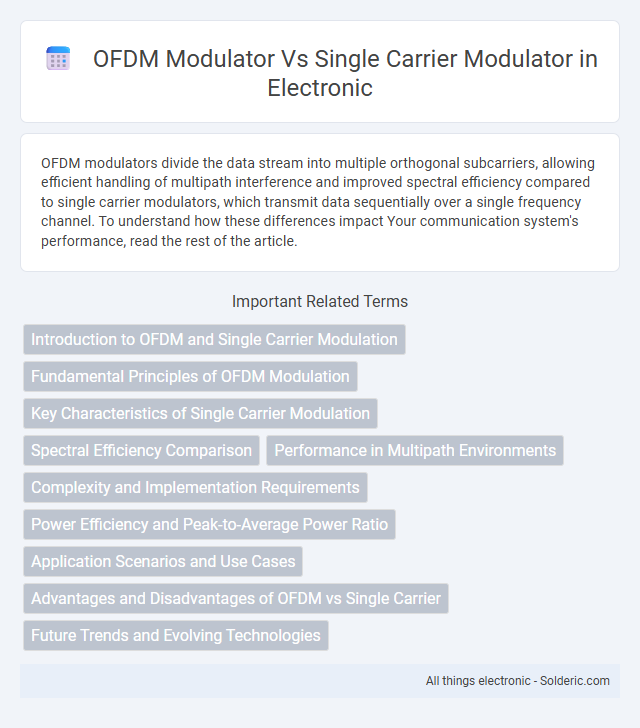OFDM modulators divide the data stream into multiple orthogonal subcarriers, allowing efficient handling of multipath interference and improved spectral efficiency compared to single carrier modulators, which transmit data sequentially over a single frequency channel. To understand how these differences impact Your communication system's performance, read the rest of the article.
Comparison Table
| Feature | OFDM Modulator | Single Carrier Modulator |
|---|---|---|
| Signal Structure | Multiple orthogonal subcarriers | Single wideband carrier |
| Frequency Selectivity | High immunity to frequency selective fading | More affected by frequency selective fading |
| Complexity | Higher complexity due to FFT/IFFT processing | Lower complexity, straightforward modulation |
| Multipath Resistance | Strong multipath mitigation with cyclic prefix | Requires complex equalization for multipath |
| Peak-to-Average Power Ratio (PAPR) | High PAPR, less power efficient | Low PAPR, more power efficient |
| Channel Estimation | Easier via pilot subcarriers | More challenging without pilots |
| Typical Applications | Broadband wireless, LTE, WiFi, 5G | Traditional voice systems, some satellite comms |
Introduction to OFDM and Single Carrier Modulation
Orthogonal Frequency Division Multiplexing (OFDM) modulator divides a high-rate data stream into multiple lower-rate streams transmitted simultaneously over orthogonal subcarriers, enhancing spectral efficiency and robustness against multipath fading. Single Carrier Modulation transmits data sequentially over a single frequency channel, offering simpler implementation and lower peak-to-average power ratio (PAPR) but is more susceptible to inter-symbol interference in frequency-selective channels. OFDM is widely utilized in modern broadband systems like LTE and Wi-Fi, while Single Carrier Modulation remains relevant in scenarios with stringent power constraints or simpler channel conditions.
Fundamental Principles of OFDM Modulation
OFDM modulation divides a high-rate data stream into multiple lower-rate streams, transmitting them simultaneously over orthogonal subcarriers to minimize inter-symbol interference and maximize spectral efficiency. In contrast, single carrier modulation sends data sequentially over a single carrier frequency, making it more susceptible to multipath fading and requiring complex equalization. Your communication system benefits from OFDM's orthogonality and parallel processing, enhancing robustness in frequency-selective channels compared to traditional single carrier techniques.
Key Characteristics of Single Carrier Modulation
Single carrier modulation transmits data using a single frequency carrier wave, resulting in a simpler transmitter and receiver architecture compared to OFDM modulators. It typically experiences higher inter-symbol interference (ISI) in multipath environments, requiring complex equalization techniques to maintain signal integrity. Single carrier schemes offer lower peak-to-average power ratio (PAPR), improving power amplifier efficiency and making them suitable for uplink transmissions in wireless communication systems.
Spectral Efficiency Comparison
OFDM modulators offer higher spectral efficiency than single carrier modulators by dividing the available bandwidth into multiple orthogonal subcarriers, enabling simultaneous data transmission and minimizing inter-symbol interference. Single carrier modulators, while simpler, suffer from lower spectral efficiency due to their vulnerability to multipath fading and increased guard interval requirements. Your choice of modulation impacts bandwidth utilization and overall communication system performance, with OFDM often preferred in modern high-speed wireless networks.
Performance in Multipath Environments
OFDM modulators excel in multipath environments by dividing the channel into multiple orthogonal subcarriers, effectively mitigating inter-symbol interference and enhancing signal robustness. Single carrier modulators often suffer from severe distortion in such conditions due to overlapping echoes causing symbol overlap. Your network performance in challenging multipath scenarios significantly improves with OFDM, making it the preferred choice for modern wireless communication systems.
Complexity and Implementation Requirements
OFDM modulators require higher complexity due to the use of Fast Fourier Transform (FFT) algorithms and intricate synchronization processes, demanding more processing power and memory compared to single carrier modulators. Single carrier modulators have simpler implementation requirements, benefiting from straightforward modulation and equalization techniques, which reduce hardware and computational resource needs. Your choice between the two depends on balancing advanced performance advantages of OFDM with practical constraints in system design and processing capabilities.
Power Efficiency and Peak-to-Average Power Ratio
OFDM modulators exhibit lower power efficiency due to their high peak-to-average power ratio (PAPR), which requires linear power amplifiers operating with significant back-off to avoid distortion. Single carrier modulators typically achieve better power efficiency by maintaining a lower PAPR, enabling amplifiers to operate closer to saturation with less signal distortion. Understanding these differences helps you optimize system design for energy consumption and signal integrity in communication applications.
Application Scenarios and Use Cases
OFDM modulators excel in high-data-rate wireless communication systems such as 4G LTE, 5G NR, and Wi-Fi, where multipath fading and frequency selectivity require robust spectral efficiency and resistance to intersymbol interference. Single carrier modulators are commonly used in low-complexity, power-sensitive applications like satellite communications and some IoT devices due to their simpler receiver design and lower peak-to-average power ratio (PAPR). OFDM is preferred in broadband, multipath-rich environments, while single carrier modulation suits narrowband channels and scenarios demanding high power efficiency.
Advantages and Disadvantages of OFDM vs Single Carrier
OFDM modulators offer superior resistance to multipath fading and inter-symbol interference due to their use of multiple orthogonal subcarriers, enabling higher spectral efficiency and robust performance in wireless channels compared to single carrier modulators. Single carrier modulators, while simpler and having lower peak-to-average power ratio (PAPR), suffer from increased complexity in equalization and reduced robustness in frequency-selective fading environments. OFDM systems typically require more complex synchronization and suffer from high PAPR, which can lead to power inefficiencies and nonlinear distortion in power amplifiers.
Future Trends and Evolving Technologies
OFDM modulators dominate emerging wireless communication standards like 5G and Wi-Fi 6, driven by their robustness against multipath fading and spectral efficiency that supports high data rates and massive MIMO implementations. Single carrier modulators remain relevant in scenarios prioritizing low PAPR and simple receiver designs, particularly in uplink transmissions within 5G NR. Future trends indicate hybrid approaches combining OFDM and single carrier technologies to optimize power efficiency and latency in evolving IoT and mmWave communication systems.
OFDM modulator vs single carrier modulator Infographic

 solderic.com
solderic.com